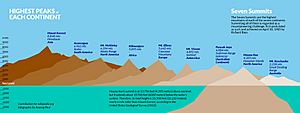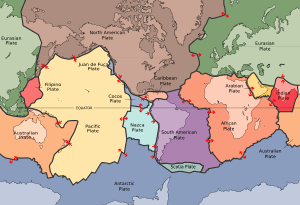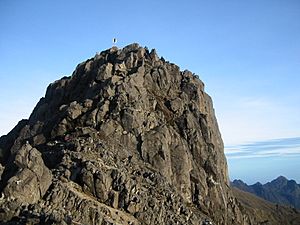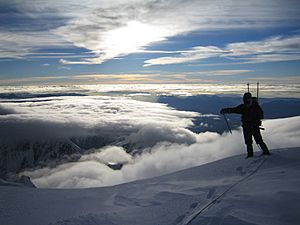Seven Summits facts for kids
The Seven Summits are the tallest mountains on each of the seven continents. Climbing all of them is a big challenge for mountaineers. The first person to do this was Richard Bass on April 30, 1985. Many climbers now aim to complete this goal. If you climb all Seven Summits and also reach the North and South Poles, it's called the Explorers Grand Slam.
Contents
What are the Seven Summits?
The Seven Summits are the highest peaks on each of the world's seven continents. There are a few different lists because people don't always agree on where continents begin and end. This mainly affects two areas:
- For Europe, some lists include Mont Blanc, while others include Mount Elbrus.
- For Oceania, some lists include all of Oceania, meaning Puncak Jaya (also known as "Carstensz Pyramid") is the highest. Other lists only count mainland Australia, making Mount Kosciuszko the highest.
Because of these differences, there are a few possible versions of the Seven Summits. Sometimes, people even climb an "Eight Summits" list to include both Puncak Jaya and Mount Kosciuszko, along with the other six peaks.
The most common lists are:
- The Messner version: Everest, Aconcagua, Denali, Kilimanjaro, Vinson, Elbrus, and Puncak Jaya.
- The Bass version: Everest, Aconcagua, Denali, Kilimanjaro, Vinson, Elbrus, and Kosciuszko.
Richard Bass and his climbing partner Frank Wells wanted to be the first to climb the highest mountain on each continent. They climbed Aconcagua for South America, Denali (then called McKinley) for North America, Kilimanjaro for Africa, Elbrus for Europe, Vinson for Antarctica, Kosciuszko for Australia, and finally Everest for Asia.
Continents and Tectonic Plates
The Earth's surface is made of huge pieces called tectonic plates. If we use these plates to define continents, the list of highest points changes a bit. For example, Europe and Asia could be seen as one large continent called Eurasia, with Mount Everest as its highest point.
Here are the highest points on some of the largest tectonic plates:
- African Plate – Kilimanjaro
- Antarctic Plate – Vinson Massif
- Australian Plate – Puncak Jaya or Kosciuszko
- Eurasian Plate – Mount Everest
- North American Plate – Denali
- Pacific Plate – Mauna Kea (a volcano in Hawaii)
- South American Plate – Aconcagua
Australia's Highest Mountain
The highest mountain on the Australian mainland is Mount Kosciuszko, which is 2,228 meters (7,310 feet) high. However, if you consider the entire Australian continent, which includes Australia and New Guinea, the highest mountain is Puncak Jaya. It is 4,884 meters (16,024 feet) high and is located in Indonesia on the island of New Guinea.
Mount Kosciuszko is quite easy to climb; it's a four-hour walk from a nearby car park. Puncak Jaya, on the other hand, is a much more difficult climb, requiring a full mountaineering expedition.
Some people say Mount Wilhelm (4,509 meters or 14,793 feet) in Papua New Guinea is the highest mountain in Australia. This is because they consider the Indonesian part of New Guinea to be part of Asia. However, this idea is based on political borders, not on the Earth's geography.
Europe's Highest Mountain
Most people agree that Mount Elbrus (5,642 meters or 18,510 feet) in the Caucasus is the highest peak in Europe. This mountain is on both the Bass and Messner lists. But the exact border between Asia and Europe is not always clear. If one border definition is used, Elbrus is in Asia. If another is used, it's in Europe.
Because of this, some people believe Mont Blanc (4,810 meters or 15,781 feet) is the highest mountain entirely within Europe. Mont Blanc is located on the border between France and Italy in the Graian Alps.
The Bass and Messner Lists Compared
The first list of Seven Summits was created by Richard Bass. His list (the Bass or Kosciuszko list) chose Mount Kosciuszko (2,228 meters or 7,310 feet) as the highest point for the Australian continent.
Later, Reinhold Messner suggested a different list (the Messner or Carstensz list). He replaced Mount Kosciuszko with Puncak Jaya, also known as Carstensz Pyramid (4,884 meters or 16,024 feet), which is in Indonesia.
Neither the Bass nor the Messner list includes Mont Blanc. From a climber's point of view, the Messner list is harder. Climbing Carstensz Pyramid is a true expedition, while climbing Kosciuszko is more like a long hike. Climber Patrick Morrow explained that he chose the Messner list because Carstensz Pyramid was a "true mountaineer's objective."
| Image | Peak | Bass list | Messner list | Height | Continent | Mountain Range | Country | First climb |
|---|---|---|---|---|---|---|---|---|
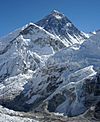 |
Mount Everest | ✔ | ✔ | 8,848 m (29,031 ft) | Asia | Himalaya | Nepal / China | 1953 |
 |
Aconcagua | ✔ | ✔ | 6,961 m (22,838 ft) | South America | Andes | Argentina | 1897 |
 |
Denali | ✔ | ✔ | 6,194 m (20,322 ft) | North America | Alaska Range | United States | 1913 |
 |
Kilimanjaro | ✔ | ✔ | 5,895 m (19,341 ft) | Africa | – | Tanzania | 1889 |
 |
Mount Elbrus | ✔ | ✔ | 5,642 m (18,510 ft) | Europe | Caucasus Mountains | Russia | 1874 |
 |
Mount Vinson | ✔ | ✔ | 4,892 m (16,050 ft) | Antarctica | Sentinel Range | – | 1966 |
 |
Puncak Jaya | ✔ | 4,884 m (16,024 ft) | Australia | Sudirman Range | Indonesia | 1962 | |
 |
Mount Kosciuszko | ✔ | 2,228 m (7,310 ft) | Australia | Great Dividing Range | Australia | Unknown |
Images for kids
See also
 In Spanish: Siete Cumbres para niños
In Spanish: Siete Cumbres para niños


